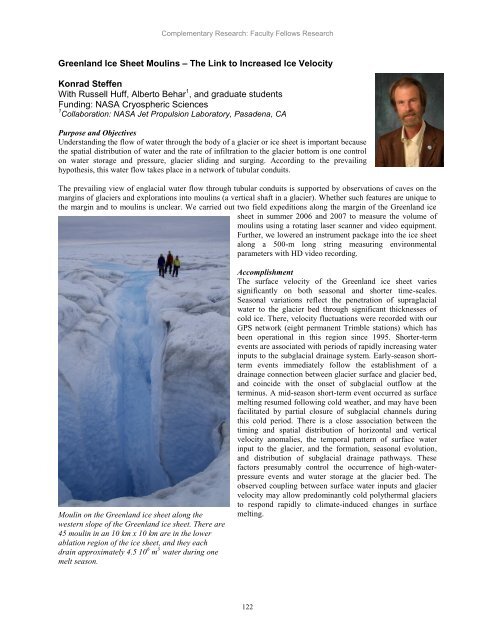Scientific Theme: Advanced Modeling and Observing Systems
Scientific Theme: Advanced Modeling and Observing Systems
Scientific Theme: Advanced Modeling and Observing Systems
Create successful ePaper yourself
Turn your PDF publications into a flip-book with our unique Google optimized e-Paper software.
Complementary Research: Faculty Fellows Research<br />
Greenl<strong>and</strong> Ice Sheet Moulins – The Link to Increased Ice Velocity<br />
Konrad Steffen<br />
With Russell Huff, Alberto Behar 1 , <strong>and</strong> graduate students<br />
Funding: NASA Cryospheric Sciences<br />
1 Collaboration: NASA Jet Propulsion Laboratory, Pasadena, CA<br />
Purpose <strong>and</strong> Objectives<br />
Underst<strong>and</strong>ing the flow of water through the body of a glacier or ice sheet is important because<br />
the spatial distribution of water <strong>and</strong> the rate of infiltration to the glacier bottom is one control<br />
on water storage <strong>and</strong> pressure, glacier sliding <strong>and</strong> surging. According to the prevailing<br />
hypothesis, this water flow takes place in a network of tubular conduits.<br />
The prevailing view of englacial water flow through tubular conduits is supported by observations of caves on the<br />
margins of glaciers <strong>and</strong> explorations into moulins (a vertical shaft in a glacier). Whether such features are unique to<br />
the margin <strong>and</strong> to moulins is unclear. We carried out two field expeditions along the margin of the Greenl<strong>and</strong> ice<br />
sheet in summer 2006 <strong>and</strong> 2007 to measure the volume of<br />
moulins using a rotating laser scanner <strong>and</strong> video equipment.<br />
Further, we lowered an instrument package into the ice sheet<br />
along a 500-m long string measuring environmental<br />
parameters with HD video recording.<br />
Moulin on the Greenl<strong>and</strong> ice sheet along the<br />
western slope of the Greenl<strong>and</strong> ice sheet. There are<br />
45 moulin in an 10 km x 10 km are in the lower<br />
ablation region of the ice sheet, <strong>and</strong> they each<br />
drain approximately 4.5 10 6 m 3 water during one<br />
melt season.<br />
Accomplishment<br />
The surface velocity of the Greenl<strong>and</strong> ice sheet varies<br />
significantly on both seasonal <strong>and</strong> shorter time-scales.<br />
Seasonal variations reflect the penetration of supraglacial<br />
water to the glacier bed through significant thicknesses of<br />
cold ice. There, velocity fluctuations were recorded with our<br />
GPS network (eight permanent Trimble stations) which has<br />
been operational in this region since 1995. Shorter-term<br />
events are associated with periods of rapidly increasing water<br />
inputs to the subglacial drainage system. Early-season shortterm<br />
events immediately follow the establishment of a<br />
drainage connection between glacier surface <strong>and</strong> glacier bed,<br />
<strong>and</strong> coincide with the onset of subglacial outflow at the<br />
terminus. A mid-season short-term event occurred as surface<br />
melting resumed following cold weather, <strong>and</strong> may have been<br />
facilitated by partial closure of subglacial channels during<br />
this cold period. There is a close association between the<br />
timing <strong>and</strong> spatial distribution of horizontal <strong>and</strong> vertical<br />
velocity anomalies, the temporal pattern of surface water<br />
input to the glacier, <strong>and</strong> the formation, seasonal evolution,<br />
<strong>and</strong> distribution of subglacial drainage pathways. These<br />
factors presumably control the occurrence of high-waterpressure<br />
events <strong>and</strong> water storage at the glacier bed. The<br />
observed coupling between surface water inputs <strong>and</strong> glacier<br />
velocity may allow predominantly cold polythermal glaciers<br />
to respond rapidly to climate-induced changes in surface<br />
melting.<br />
122
















